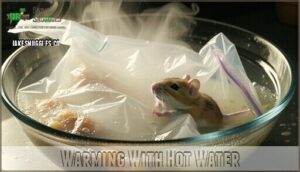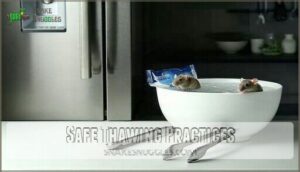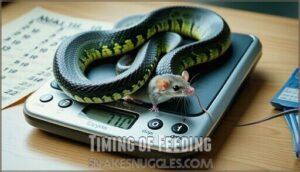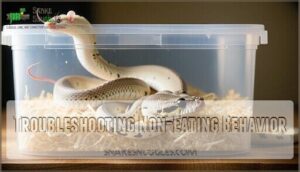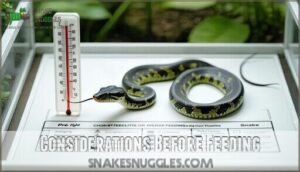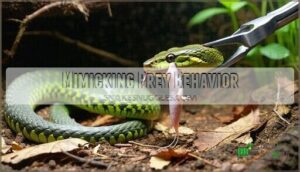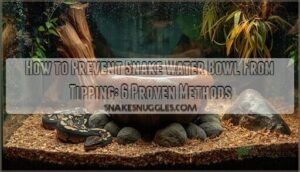This site is supported by our readers. We may earn a commission, at no cost to you, if you purchase through links.
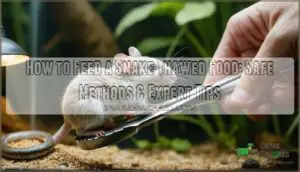
First, move frozen prey from freezer to refrigerator overnight – patience pays off here.
Next, submerge the rodent in warm water for 10-15 minutes until it reaches body temperature.
Use feeding tongs to present the prey, wiggling it slightly to mimic natural movement.
Your snake’s heat sensors need that warmth to recognize dinner.
Never use microwaves or hot water, as these create dangerous hot spots.
Feed in a separate container to avoid substrate ingestion.
The process becomes second nature once you understand your snake’s feeding triggers and behavioral cues.
Table Of Contents
- Key Takeaways
- How to Feed a Snake Thawed Food?
- Thawing Rodents in Refrigerator
- Submerging in Cold Water
- Warming With Hot Water
- Safe Thawing Practices
- Feeding Techniques With Tongs
- Timing of Feeding
- Troubleshooting Non-Eating Behavior
- Considerations Before Feeding
- Precautions and Tips
- Mimicking Prey Behavior
- Frequently Asked Questions (FAQs)
- How do you feed a thawed snake?
- Can snakes eat thawed prey?
- How do you Thaw a snake?
- How do you thaw a snake feeder?
- Can a snake thaw frozen prey in the microwave?
- How do you get a snake to eat your food?
- How to feed a snake frozen and thawed?
- How do you feed a frozen thawed rat to a ball python?
- How do you prepare frozen food for snakes?
- Can you feed snakes frozen food?
- Conclusion
Key Takeaways
- Thaw prey safely by moving frozen rodents from the freezer to the refrigerator overnight, then submerge them in cold water for 30-60 minutes if you need faster results – never use microwaves, as they create dangerous hot spots that can burn your snake’s mouth.
- Warm thawed prey to 100-110°F using hot water before feeding – your snake’s heat sensors need that body temperature warmth to recognize the food as prey and trigger their natural feeding response.
- Use feeding tongs to present the prey with slight wiggling movements – this mimics natural prey behavior and keeps you safe from accidental bites while triggering your snake’s hunting instincts.
- Feed in a separate container and monitor your snake’s feeding schedule based on age – juveniles need weekly meals, while adults can wait 7-14 days between feedings, and you should never feed during shedding cycles, when their eyes turn milky.
How to Feed a Snake Thawed Food?
Feeding your snake thawed food isn’t rocket science, but it does require some know-how.
Start by thawing frozen snake food safely in the refrigerator overnight, then submerge it in cold water for quicker results.
The Thawed Food Benefits include better Prey Storage Safety and consistent Nutritional Prey Selection.
Warm the prey to 100-110°F using hot water before feeding snakes.
Always use tongs when Handling Frozen Prey to mimic natural movement and trigger your snake’s hunting instincts.
This method offers Feeding Schedule Variety while ensuring your pet gets proper nutrition.
These snake feeding tips make mealtime stress-free for both you and your serpent.
Thawing Rodents in Refrigerator
Your snake deserves a meal that’s safe and properly prepared. The refrigerator method remains the gold standard for overnight thawing of frozen rodents. Simply place your frozen snake food in a sealed plastic bag and let your fridge work its magic for 8-12 hours.
Your snake deserves dinner done right – slow refrigerator thawing beats shortcuts every time for safe, nutritious meals.
This slow thawing time maintains ideal fridge temperature around 40°F, preventing harmful bacteria growth while preserving nutritional quality.
Here’s what makes refrigerator thawing so effective:
- Food safety comes first – controlled temperatures prevent dangerous bacterial contamination
- Thawed snake food retains its natural texture and nutritional value
- Peace of mind knowing your feeding snakes routine follows veterinary-recommended practices
This method beats shortcuts every time!
Submerging in Cold Water
Once you’ve given your frozen rodents their overnight chill in the fridge, it’s time to speed things up with cold water. This method’s your best friend when you’re running behind schedule.
Grab a sealed plastic bag and place your bagged rodents inside a container filled with cold tap water. Keep that water temperature between 40-50°F – think cool but not icy. Your thawing duration should be 30-60 minutes, depending on prey size.
This approach cuts down waiting time while keeping contamination risks low. The sealed bag acts like a protective barrier, preventing nasty bacteria from crashing the party. Fresh water quality matters here, so don’t use that murky bowl sitting around.
One of the advantages of using frozen rodents is to guarantee humane euthanasia. Watch the clock though. Leaving your thawed snake food soaking too long can turn dinner into a soggy mess. This safe thawing method gives you control over timing without sacrificing your snake’s health.
Warming With Hot Water
After your rodent has finished its cold water bath, it’s time for the final warming step. Fill a bowl with hot water at your ideal temperature of 100-110°F – think warm bath water, not scalding coffee. Place the bagged rodent into this warm water for your warming duration of 10-15 minutes.
Here’s where water quality matters. Use clean tap water to avoid contamination risks that could harm your snake. For a more convenient setup, consider products for this purpose.
Gently swirl the bag occasionally to guarantee even warming throughout the prey – you don’t want cold spots that might turn off picky eaters.
For stubborn snake feeding situations, try warming just the head area with a blow dryer. This releases appealing scents that can trigger feeding responses. Some keepers add a pinch of soiled bedding to the container, mimicking natural hunting environments. Remember, proper rodent thawing methods make all the difference between a successful meal and a frustrated snake owner.
Safe Thawing Practices
After warming your snake’s meal with hot water, proper safe thawing practices become your next priority. Think of it like handling raw chicken – you wouldn’t want cross-contamination in your kitchen!
Avoid microwave dangers and refreezing risks that can turn your frozen rodents into bacterial breeding grounds. One key advantage is that frozen prey is safer than live prey.
Here’s how to master rodent thawing methods safely:
- Use refrigeration thawing or cold water methods exclusively – never microwave thawed food
- Handle all prey with dedicated tongs to prevent contamination during food handling
- Discard unused prey immediately – don’t let it sit around like yesterday’s leftovers, to maintain proper hygiene and prevent bacterial growth.
Feeding Techniques With Tongs
Proper tongs make snake feeding safer and more effective. Choose feeding tongs with expanded jaws that distribute pressure evenly across the prey. Tongs material safety matters – stainless steel works best for easy cleaning and durability.
When presenting thawed food, grip the rodent at its tail base or mid-body for ideal control. Your prey presentation angle should position the meal slightly above your snake’s head, triggering their natural feeding response. Gently wiggle the rodent to simulate movement – this mimicking live prey technique often seals the deal with hesitant eaters.
Maintaining proper tongs grip strength prevents accidentally dropping food mid-strike. Practice your feeding techniques with boiled eggs before the real thing. Once your snake strikes, release immediately to avoid injury. These snake feeding safety measures protect both you and your pet while ensuring successful meals.
Remember, avoiding snake bites starts with keeping proper distance and using appropriate tools. Never attempt hand-feeding thawed food – that’s asking for trouble. Using tongs also helps to minimize accidental bites.
Timing of Feeding
Timing transforms snake feeding from guesswork into precision. Your snake feeding schedule depends heavily on Snake Age – juveniles need weekly meals while adults can wait 7-14 days between feedings.
Watch your snake’s Activity Level for hunger cues like increased movement or tongue flicking. Seasonal Variation affects appetite too. During winter, many snakes eat less frequently, while breeding season may boost their hunger.
Never feed during the Shedding Cycle when their eyes turn milky – they can’t see prey properly and often refuse food anyway. Consider Digestion Time before offering another meal. If your snake hasn’t defecated since its last feeding, wait.
A good reptile feeding rule: most snake diet schedules work best when you feed diurnal species during daylight hours and nocturnal ones after dark. This snake feeding approach mimics their natural hunting patterns, improving acceptance rates substantially.
Troubleshooting Non-Eating Behavior
When your snake turns its nose up at dinner, it’s like dealing with a picky toddler – frustrating but fixable. Snake feeding issues with noneating behavior are more common than you’d think.
Start with scenting techniques – rub the prekilled prey with something appealing like a dead frog or bird feather. Place your snake and the rodent in an empty container to eliminate distractions and create a focused hunting environment.
A blow dryer can warm the prey and release enticing odors that trigger feeding responses. For particularly stubborn cases, try braining the rodent – it sounds gross but works.
If your snake’s used to live feeding, you might need 12-14 live prey sessions before switching back to feeding frozen rodents. Monitor your snake’s weight closely.
Persistent refusal warrants vet consultation – sometimes underlying health issues affect snake diet preferences more than we realize.
Considerations Before Feeding
Before you serve up your snake’s next meal, you’ll need to check a few important boxes to guarantee feeding goes smoothly.
Think of it as a pre-flight checklist for snake parents—your pet’s health status, proper thawing methods, and prey size all matter more than you might expect.
Snakes Health Status
Even experienced reptile keepers sometimes overlook their snake’s well-being before feeding time.
Your snake’s health directly impacts its appetite and ability to digest food safely.
Watch for these warning signs that indicate you should postpone feeding:
- Shedding Issues – Skip feeding when your snake’s eyes turn milky or skin appears dull, as this natural process affects their appetite and vision.
- Regurgitation Risks – Don’t feed if your snake hasn’t defecated recently, as this increases chances of bringing food back up.
- Environmental Impact – Check that temperatures and humidity levels match your species’ needs, since poor conditions cause feeding refusal and digestive problems.
Proper Thawing Techniques
Getting thawed food right prevents your snake from turning up its nose at dinner. Never use microwaves—they create hot spots that make prey unappetizing and pose microwave dangers.
Refrigerator thawing works best: place frozen food in sealed bags overnight. Need faster results? Try a cold water bath for 30-60 minutes.
Remember, refreezing risks bacterial growth, so use thawed prey within 24 hours for ideal food handling.
| Method | Duration |
|---|---|
| Refrigerator thawing | 12-24 hours |
| Cold water bath | 30-60 minutes |
| Final warming | 10-15 minutes |
| Safe thawing window | Use within 24 hours |
Appropriate Prey Size
Selecting the right prey size prevents overfeeding risks and aids proper snake nutrition.
Your frozen rodents should never exceed 1.5 times your snake’s widest girth matching point.
Growth stages require different sizing—juveniles need smaller meals more frequently.
Prey variety keeps feeding interesting, while proper sizing aids regurgitation prevention.
When in doubt, choose smaller thawed food over risking digestive issues.
Precautions and Tips
Your snake’s health hinges on proper hygiene protocols when handling thawed food. Always wash hands before and after feeding sessions to prevent contamination. Store frozen food separately from human meals, and remember—refreezing dangers are real since bacteria multiply rapidly in previously thawed prey.
Essential safe handling practices include:
- Inspect prey quality before each feeding session
- Keep emergency food supplies for picky eaters
- Disinfect feeding tools regularly to maintain cleanliness
Following these snake feeding precautions guarantees food safety while keeping your serpent healthy and happy.
Mimicking Prey Behavior
Beyond safety measures, mimicking prey behavior transforms feeding time from a simple meal drop into an engaging hunt. Your snake’s predatory instincts don’t disappear just because you’re offering thawed food instead of live prey.
Use feeding tools like tongs to create realistic movement patterns that stimulate hunting responses. Gently wiggle the rodent near your snake’s head, simulating the erratic movements of frightened prey.
This live motion mimicry often triggers striking in reluctant feeders. Scenting can boost your prey presentation – try rubbing the rodent with bedding from your snake’s enclosure.
Once your snake enters hunting mode, you’ll notice increased tongue flicking and focused attention. When your snake strikes, don’t immediately release the prey.
Hold on briefly to mimic a struggling animal – this convinces your snake it’s caught something worth eating. Sometimes the best magic trick is making dinner look alive again.
Frequently Asked Questions (FAQs)
How do you feed a thawed snake?
Slow and steady wins the race when feeding your thawed snake.
Use tongs to present the properly warmed prey near your snake’s head, moving it slightly to trigger their natural hunting instincts and feeding response.
Can snakes eat thawed prey?
Yes, snakes can safely eat thawed prey when it’s properly prepared.
You’ll need to thaw frozen rodents completely in the refrigerator, then warm them to 100-110°F before feeding your snake.
How do you Thaw a snake?
You don’t thaw snakes—you thaw their frozen prey food! Place bagged rodents in the refrigerator overnight or submerge in cold water for 30-60 minutes, then warm before feeding.
How do you thaw a snake feeder?
Place frozen snake feeders in the refrigerator overnight for safe thawing.
If you’re in a hurry, submerge the bagged rodent in cold water for 30-60 minutes—it’s faster and still keeps everything safe.
Can a snake thaw frozen prey in the microwave?
Microwaving frozen snake prey isn’t recommended since it creates hot spots that can burn your snake’s mouth and compromise food safety.
You’ll get better results using refrigerator thawing or cold water methods instead.
How do you get a snake to eat your food?
Use feeding tongs to wiggle the thawed prey near your snake’s head, mimicking natural movement.
Warm the rodent to 100-110°F first.
If your snake’s still picky, try scenting the prey with familiar smells.
How to feed a snake frozen and thawed?
Start by moving frozen rodents to your refrigerator overnight for safe thawing.
Once completely defrosted, warm them in hot water until they reach 100-110°F, then present using feeding tongs to trigger your snake’s natural hunting response.
How do you feed a frozen thawed rat to a ball python?
Perfectly prepared python portions require patience.
Thaw your frozen rat completely in the fridge overnight, warm it with hot water to 100-110°F.
Then use feeding tongs to present it near your ball python’s head.
How do you prepare frozen food for snakes?
Thaw frozen prey overnight in your refrigerator or submerge the bagged rodent in cold water for 30-60 minutes. Then warm it in hot water to reach 100-110°F before feeding.
Can you feed snakes frozen food?
Like serving ice cream straight from the freezer, you can’t feed snakes frozen food directly.
You’ll need to thaw it first in the refrigerator or cold water, then warm it properly before feeding, which involves a complete process to ensure the snake’s safety.
Conclusion
Like mastering a musical instrument, learning how to feed a snake thawed food becomes effortless with practice.
You’ve now got the essential techniques: proper thawing, safe warming methods, and presentation skills.
Remember, patience trumps speed when defrosting prey.
Your snake’s feeding response depends on correct temperatures and natural movements.
Soon, you’ll read your pet’s cues like a seasoned herpetologist, and with these proven methods, feeding time transforms from stressful guesswork into confident routine care.
- https://www.thesprucepets.com/feeding-snakes-frozen-mice-1239476
- https://www.petmd.com/reptile/pet-python-snake-care-sheet
- https://talis-us.com/blogs/news/the-importance-of-proper-snake-pet-diet-a-comprehensive-guide-1?srsltid=AfmBOorrWFsKW7E2A_hF808G9fQGNN1cE1SUR-YgFXWJSHRln2XrhHaf
- https://www.quora.com/How-often-do-pet-snakes-need-to-be-fed-and-what-should-you-feed-them-when-they-arent-feeding-on-live-prey-if-so-any-suggestions
- http://blogs.thatpetplace.com/thatreptileblog/2014/07/11/thawing-frozen-mice-and-rats-for-snakes-and-other-reptiles/


